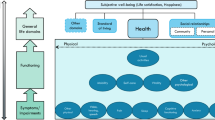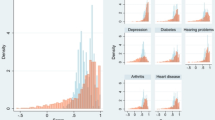Abstract
There remains considerable disagreement concerning the preferred generic utility-based measure of health-related quality of life for use in constructing quality-adjusted life years. The recent appearance (in a published form) of a new measure, the SF-6D, has highlighted this issue. The SF-6D and EQ-5D have many similarities, but marked variation has been shown in the results generated by the two instruments. The study reported here is an exploration of why such divergent results exist. There are two possible explanations: variation in the descriptive component of the instruments and variation in the values applied to health states. The results suggest two important conclusions. First, the SF-6D can describe severe health states, including states that (according to the EQ-5D scoring algorithm) are viewed as worse than the state of being ‘dead’. Second, much of the large discrepancy between the results generated using the two instruments appears to stem from very different valuations being placed on similar health states.



Similar content being viewed by others
References
Bosch J, Hunink M (2000) Comparison of the Health Utilities Index mark 3 (HUI3) and the EuroQol EQ-5D in patients treated for intermittent claudication. Qual Life Res 9:591–601
Brazier J, Deverill M, Green C, Harper R, Booth A (1999) A review of the use of health status measures in economic evaluation. Health Technol Assess 3 (9)
Brazier J, Roberts J, Tsuchiya A, Busschbach J (2001) A comparison of the EQ-5D and SF-6D across seven patient groups. Health Econ 13:873–884
Brazier J, Roberts J, Deverill M (2002) The estimation of a preference-based measure of health from the SF-36. J Health Econ 21:271–292
Coons S, Rao S, Keininger D, Hays R (2000) A comparative review of generic quality of life instruments. Pharmacoeconomics 17:13–35
Dolan P (1997) Modelling valuations for EuroQol health states. Med Care 35:1095–1108
Dolan P, Sutton M (1997) Mapping visual analogue scale health state valuations onto standard gamble and time trade-off values. Soc Sci Med 10:1519–1530
Elvik R (1995) The validity of using health state indexes in measuring the consequences of traffic injury for public health. Soc Sci Med 40:1385–1398
Glick H, Polsky D, Willke R, Schulman K (1999) A comparison of preference assessment instruments used in a clinical trial: responses to the visual analog scale from the EuroQol EQ-5D and the Health Utilities Index. Med Decis Making 19:265–274
Haan R de, Aaronson N, Limberg M, Langton R, van Crevel H (1993) Measuring quality of life in stroke. Stroke 24:320–327
Hawthorne G, Richardson J, Day NA (2001) A comparison of the assessment of quality of life (AQoL) with four other generic utility instruments. Ann Intern Med 33:358–370
Hill SR, Mitchell AS, Henry DA (2000) Problems with the interpretation of pharmacoeconomic analyses. JAMA 283:2116–2121
Holland R, Smith RD, Harvey I, Swift L, Lenaghan E (2004) Assessing quality of life in the elderly: a direct comparison of the EQ-5D and AQoL. Health Econ 13:793–805
Hollingworth W, Mackenzie R, Todd CJ, Dixon AK (1995) Measuring changes in quality of life following magnetic resonance imaging of the knee: SF-36, EuroQol or Rosser Index? Qual Life Res 4:325–334
Longworth L, Bryan S (2003) An empirical comparison of EQ-5D and SF-6D in liver transplant patients. Health Econ 12:1061–1067
Longworth L, Ratcliffe J, Young T, Bryan S (2001) A comparison of the EQ-5D and SF-6D single index in assessing the health-related quality of life of liver transplant patients. Proceedings of the 18th Plenary Meeting of the EuroQol Group
Longworth L, Young T, Ratcliffe J, Bryan S, Buxton M (2001) The cost-effectiveness of liver transplantation for three disease categories. Report for the Department of Health
Lubetkin E, Gold M (2001) Areas of decrement in health-related quality of life in a health center population, Proceedings of the 18th Plenary Meeting of the EuroQol Group, pp 149–160
Nord E, Richardson J, Macarounas-Kirchmann K (1993) Social evaluation of health care versus personal evaluation of health states: evidence on the validity of four health—state scaling instruments using Norwegian and Australian Surveys. Int J Technol Assess Health Care 9:463–478
O’Brien BJ, Spath M, Blackhouse G, Severens JL, Dorian P, Brazier P (2003) A view from the bridge: agreement between the SF-6D utility algorithm and the Health Utilities Index. Health Econ 12:975–981
Raftery J (2001) NICE: faster access to modern treatments? Analysis of guidance on health technologies. BMJ 323:1300–1303
Ratcliffe J, Longworth L, Young T, Burroughs A, Buxton M, on behalf of the Cost-effectiveness of Liver Transplantation Study Team (CELT) (2002) Assessing health related quality of life pre and post liver transplantation: a prospective multi-centre study. Liver Transpl 8:263–270
Schulz M, Chen J, Woo H, Keech M, Watson M, Davey P (2002) A comparison of techniques for eliciting patient preferences in patients with benign prostatic hyperplasia. J Urol 168:155–159
Spady B, Suarez-Almazor M (2001) A comparison of preference-based health status tools in patients with musculoskeletal disease. Proceedings of the 18th Plenary Meeting of the EuroQol Group, pp 235–243
Stavem K, Bjornaes H, Lossius M (2001) Properties of the 15D and EQ-5D Utility measures in a community sample of people with epilepsy. Epilepsy Res 44:179–189
Suarez-Almazor M, Kendall C, Johnson, Skeith K, Vincent D (2000) Use of health status measures in patients with low back pain in clinical settings. Comparison of specific, generic and preference-based instruments. Rheumatology (Oxf) 39:783–790
Torrance G, Furlong W, Feeny D (2002) Health utility estimation. Expert Rev Pharmacoecon Outcomes Res 2:99–108
Tosteson A, Hammond C (2002) Quality of life assessment in osteoporosis. Pharmacoeconomics 20:289–303
Acknowledgements
The authors thank Paul Kind who discussed an earlier version of this paper at the EuroQol Scientific Meeting. We also thank our colleagues (from Birmingham, Brunel, Aberdeen and York Universities) for their assistance in the mapping survey, and Peter Giakalis for help in identifying relevant literature. Comments from the two referees should also be acknowledged; their suggestions have strengthened the paper. The views expressed are those of the authors alone.
Author information
Authors and Affiliations
Corresponding author
Rights and permissions
About this article
Cite this article
Bryan, S., Longworth, L. Measuring health-related utility:. Eur J Health Econ 6, 253–260 (2005). https://doi.org/10.1007/s10198-005-0299-9
Issue Date:
DOI: https://doi.org/10.1007/s10198-005-0299-9




